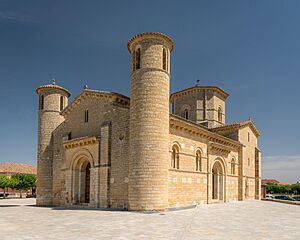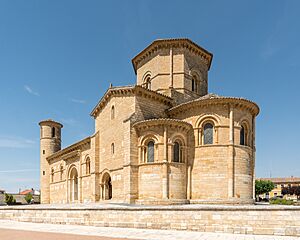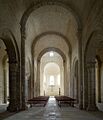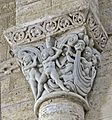Church of Saint Martin of Tours, Frómista facts for kids
Quick facts for kids Church of Saint Martin of Tours |
|
|---|---|
|
Iglesia de San Martín de Tours
|
|

West façade in 2020.
|
|
| Location | Frómista |
| Country | Spain |
| Denomination | Catholic |
| History | |
| Dedication | Martin of Tours |
| Architecture | |
| Style | Romanesque |
| Groundbreaking | 11th Century |
The Church of Saint Martin of Tours is a really old and beautiful church. It is located in Frómista, a small town in Spain. This church was built way back in the 11th century, which means it's over 900 years old! It is famous for its Romanesque style. The church stands along the Way of St. James, a famous pilgrimage route to Santiago de Compostella.
Contents
A Look at the Church's History
How the Church Was Built
The building of this church started in the second half of the 11th century. It was Queen Muniadona of Castile who wanted it built. The church was part of a monastery, but that monastery is no longer there.
The church was first mentioned in a document from 1066. Its building style is similar to other Romanesque churches. These include the Cathedral of Jaca and San Isidoro de León. All these churches are found along the Way of St. James.
Changes Over the Centuries
In 1118, the church became part of a Benedictine monastery called San Zoilo. The monks left the church in the 13th century. After that, it changed owners several times.
In the 15th century, some new parts were added to the church. These included a bell tower built over the original dome. A sacristy, which is a room for church items, was also added.
After the Middle Ages, the church started to fall apart. By the 19th century, it was no longer safe to use.
Bringing the Church Back to Life
In 1894, the church was named a National Monument. This meant it was very important and needed to be saved. A big project began to fix it up.
The restoration work brought the church back to its original look. Many parts that were added later were carefully removed. The Church of Saint Martin of Tours was reopened to visitors in 1904.
What the Church Looks Like
Outside the Church
The Church of Saint Martin of Tours has a classic Romanesque look from the outside. You can see that the main part of the church is taller than the side parts. This is shown by the different heights of the front wall.
On the sides of the church, there are two round bell towers. The part of the church that crosses the main section is as tall as the central area. However, it does not stick out wider than the side aisles.
Inside, where the main and crossing parts meet, there is an octagonal dome. The main and side parts of the church have rounded ceilings called barrel vaults. They all end in three rounded sections called apses.
Entrances and Walls
The church has four entrances. One is on the north side, one on the west, and two on the south. Today, only two of these entrances are used.
The walls of the church look very strong and solid. The few windows are shaped with rounded arches. All four sides of the church have about 300 small carvings at the top. These carvings show people, animals, and fantasy creatures. Some even show funny or playful scenes.
Above the main entrance, there is a special symbol called a chrismon. It has six arms.
Amazing Sculptures
One of the most special things about this church is its sculptures. A famous artist known as the "Maestro de la Orestíada" worked here. This artist was also called "Maestro de Jaca-Frómista."
This artist got ideas from an old Roman tomb. The tomb came from a nearby town called Husillos. Today, you can see this tomb in the National Archaeological Museum in Madrid.
The sculptures made by this artist are very detailed and lifelike. They show how good ancient Greek and Roman sculptures were at showing the human body. Other sculptors also worked on the church. Even with different artists, all the sculptures look like they belong together.
Inside the Church
The inside of the church has a simple layout. It has a main area and two side areas. These areas are separated by rows of pillars. The arches between these pillars are not very tall.
The central part of the church does not have windows high up on the walls. This means it is a pseudobasilica. The rounded ceilings of the main area and the crossing start at the same height as those of the side areas.
The rounded ends of the church, called apses, have several old sculptures. One of these is a sculpture of Christ from the 13th century. It is located in the main part of the church.
Some of the tops of the pillars, called capitals, have special designs. These designs show plants, people, or even tell stories. For example, you can see carvings of Adam and Eve or the story of the Fox and the Grapes.
Gallery
See also
 In Spanish: Iglesia de San Martín de Tours (Frómista) para niños
In Spanish: Iglesia de San Martín de Tours (Frómista) para niños







